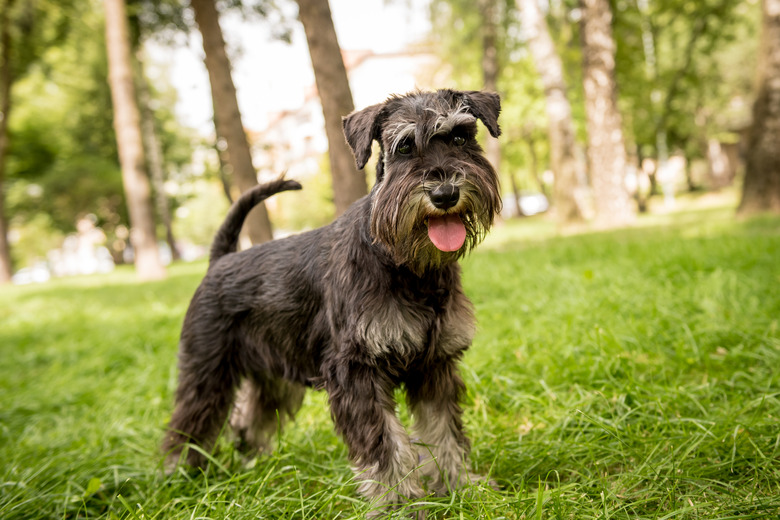What Is The Difference Between A Schnauzer And A Scottish Terrier?
Although the schnauzer and the Scottish terrier have a similar appearance, they are different breeds with different characteristics. There is only one size of Scottish terrier while there are three schnauzer sizes, each recognized as different breeds. Deciding which breed is best for you depends on the size of dog you want, as well as other characteristics including temperament and health considerations.
Comparing breed history and temperament
Comparing breed history and temperament
A member of the American Kennel Club's terrier group, the Scottish dog, or Scottie, is described as confident, independent, spirited, and dignified. Believed to be one of the oldest Scottish dog breeds, the Scottie was bred to hunt vermin such as badgers, rats, and foxes. The breed was accepted into the American Kennel Club registry in 1885.
The standard schnauzer is described as smart, fearless, and spirited and has a very similar temperament to the Scottish terrier. The schnauzer may be a bit easier to train, however, as the Scottie tends to be a bit more stubborn.
The standard schnauzer is the original breed that the giant and miniature schnauzer descended from. They were recognized by the AKC in 1904 and are members of the working group. Bred in Germany, these dogs were used as farm dogs. They were not only expected to hunt vermin but also to guard and herd. The giant schnauzer is also a member of the working group and was bred to help drive cattle. The miniature schnauzer is in the terrier group and was bred to hunt rats.
Scottish terrier vs. schnauzer sizes
Scottish terrier vs. schnauzer sizes
The Scottish terrier is a small dog that measures 10 inches tall. The males of the breed weigh 19 to 22 pounds while the females weigh 18 to 21 pounds. The AKC does not recognize dogs smaller than this as a miniature Scottish terrier. Scotties are similar in size to the miniature schnauzer. Miniature schnauzers are 12 to 14 inches tall, slightly taller than the Scottie, and weigh 11 to 20 pounds, which is slightly less than the Scottie.
When comparing the standard schnauzer vs miniature schnauzer and Scottie, the standard is quite a bit larger. Male standard schnauzers are 18.5 to 19.5 inches tall and weigh 35 to 50 pounds. Females are 17.5 to 18.5 inches tall and weigh 30 to 45 pounds.
Giant schnauzers are the largest of this group. Male giant schnauzers grow 25.5 to 27.5 inches tall and weigh 60 to 85 pounds. Females grow 23.5 to 25.5 inches tall and weigh 55 to 75 pounds.
Differences in appearance
Differences in appearance
The Scottish terrier has a compact, slightly long body with short legs. They also have a recognizable beard, eyebrows, and erect tail and ears. They have a broken coat with a wiry topcoat and a soft undercoat. Acceptable colors include black, wheaten, and brindle. A brindle Scottish terrier may have black, red, or silver markings.
The schnauzer has a similar beard and eyebrows and also features erect ears. They also have an erect tail, but it is usually docked to a length of 1 to 2 inches. The schnauzer's body has more of a square shape and they don't have short legs. They have a thick, wiry coat but only have two recognized colors: black, and pepper and salt. A black schnauzer can resemble an oversized black Scottish terrier.
A wheaten schnauzer is not recognized under the breed standard for standard schnauzers. However, the giant schnauzer comes in additional colors including fawn and black and tan.
Terrier, schnauzer health and longevity
Terrier, schnauzer health and longevity
Both breeds have genetic health concerns to consider. When selecting a dog, make sure the breeder has done the recommended health testing. The Scottish terrier should have a patella evaluation and a DNA test for Von Willebrand disease, a deficiency in a protein that is necessary for blood clotting. Scotties have an average life expectancy of about 12 years.
The standard schnauzer has a slightly longer life expectancy of 13 to 16 years. Recommended health tests for the breed include an ophthalmologist exam, hip evaluation, and a DNA test for DCM, or dilated cardiomyopathy.
Both miniature and giant schnauzers have a life expectancy of 12 to 15 years, but each has a few additional health concerns compared to the standard schnauzer and Scottie. Miniature schnauzers should have a cardiac and ophthalmology exam. They are prone to conditions such as cataracts, urinary stones, and pancreatitis. Health tests for giant schnauzers include a thyroid test, hip evaluation, and ophthalmology exam.

